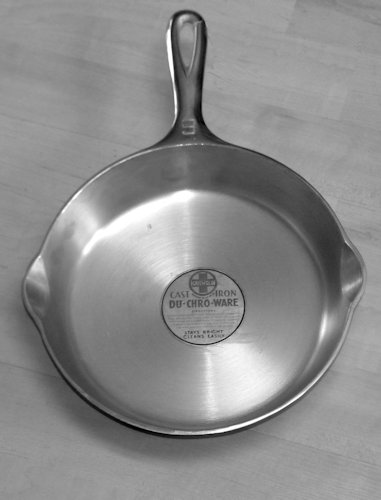Plated Finish Ware
 Manufacturers early on realized there was a segment of the market that desired the features of cast iron cookware, but perhaps did not care for its rustic appearance or the maintenance it required. One of the first ways makers addressed this issue was to offer plated versions, first in a nickel finish, and later in chromium. Nickel-plated pieces are known from as early as the 1890s, with manufacturers seen moving to chromium in the 1930s.
Manufacturers early on realized there was a segment of the market that desired the features of cast iron cookware, but perhaps did not care for its rustic appearance or the maintenance it required. One of the first ways makers addressed this issue was to offer plated versions, first in a nickel finish, and later in chromium. Nickel-plated pieces are known from as early as the 1890s, with manufacturers seen moving to chromium in the 1930s.
Plated finishes varied from a dull, silvery gray to a low luster to a bright mirror polish.
Griswold's "Silverlike" was a matte, unpolished chrome finish. It's main purpose appeared to be as rust-proofing.
Griswold's "Du Chro", said to mean "dull chrome", was a combination, the bottoms and insides being satin, the sides, tops of handles, and other highlights being highly polished. This finish may have been a bit of marketing spin on leaving unpolished those parts that would be impossible or far too labor-intensive to polish or would otherwise soon become marred by usage anyway.
Du Chro appears to have meant different things at different times and on different Griswold pieces. In some cases the "dull" aspect is a bright satin finish; in others, a flat, matte grey coating. Some skillets many consider to be simply chrome have been seen labeled "Du Chro Ware".

Wagner was only known to have plated with nickel, although a popular guide book claims the use of chrome in the 1940s-1950s. Wagner catalogs from the 1924 and 1927 feature sections of nickel-plated wares with catalog numbers different from those of their bare iron counterparts. Empirical observation, however, reveals that the nickel-plated items physically bore the same catalog numbers as those of the bare iron.
Wagner's "Silverlite", not to be confused with Griswold's "Silverlike", appears to have been simply the brand-naming of a regular, polished nickel plating. Wagner trademarked the term in 1928. First seen in advertisements that year, Silverlite was described as being "triple plated with nickel" with "a brilliant silvery finish". Advertising of Silverlite ceased in late 1939, and although still included in a 1941 catalog, an addendum indicates it had been discontinued entirely.
Although pieces were plated inside and out, many of those seen give the impression of having been made leaving the cooking surface bare iron. It appears, however, that typical wear was simply consistent enough to make that inference. If true, the application of a substance would have been necessary to prevent the plating adhering to selected areas, but it would have required something that could withstand the high temperatures and acidic environment of the plating process. NOS (new old stock) pans with labels as well as catalog verbiage ("nickel plated finishes inside and out") confirm cookware plating was an all-over process.
Plating was popular enough that even cast iron cookware toys were seen plated.
Far fewer plated pieces are seen after the early 1940s, the decline perhaps WWII-related.
As collectibles, plated pieces appear to have value exceeding their bare iron counterparts only if the plating is completely intact. Otherwise, collectors seem to prefer and value bare iron over and above even minimally worn plating.
The question often arises regarding the removal of plating from worn pieces in order to leave them bare iron. While nickeled pieces in general appear simply to be plated versions of their plain iron counterparts, chromed pieces, where a mirror finish was desired, were first machine-polished smooth. De-plated chromed pieces will therefore not be the same as the versions originally produced as bare iron.
Similarly, the question is often asked about the possibility of re-plating worn pieces. The answer is that it would in most cases be too cost-prohibitive, and the result, being inauthentic, would not be considered as valuable as an intact original.
Is it nickel or is it chrome? Older pieces, especially those produced before the 1930s, are more likely to be nickel than chrome. Wagner used only nickel. Griswold plated its earlier pieces in nickel, but switched to chrome at about the beginning of the "large block" TM era. Nickel-plated pieces usually exhibit a warmer, yellowish tone whereas chrome (chromium) gives a colder, bluish impression. Nickel is often finished only to a soft luster; chrome typically to a high, mirror-like polish, if not left satin/matte.
Plated pieces can safely be cleaned using lye, and even very fine steel wool. Self-cleaning oven treatment may permanently discolor plating. Electrolysis cleaning should be used with caution, as it could remove plating, especially if its adhesion is already compromised.

 A gallery of nickel and chrome plated pieces.
A gallery of nickel and chrome plated pieces.








